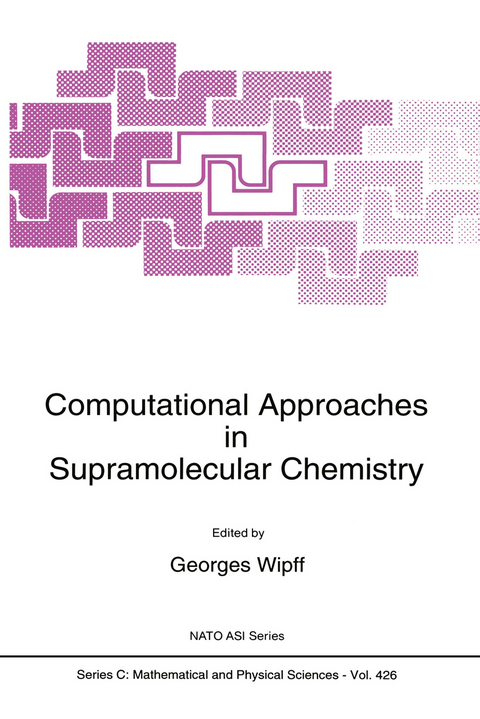
Computational Approaches in Supramolecular Chemistry
Springer (Verlag)
978-0-7923-2767-7 (ISBN)
Supramolecular chemistry has been defined by J.-M. Lehn as "a highly interdisciplinary field of science covering the chemical, physical, and biological features of chemical species of higher complexity, that are held together and organized by means of intermolecular (noncovalent) binding interactions" (Science, 1993). Recognition, reactivity, and transport represent three basic functional features, in essence dynami~s, which may be translated into structural features. The purpose of the NATO workshop which took place september 1-5, 1993 at the Bischenberg (near Strasbourg) was to present computations which may contribute to the atomic level understanding of the structural and thermodynamical features involved in the processes of molecular recognition and supramolecular organization. of "supra-molecular modeling". Other The main focus was therefore, on the many facets applications of computers in chemistry, such as automation, simulation of processes, procedures for fitting kinetic or thermodynamic data, computer assisted synthetic strategies, use of data bases for structure elucidation or for bibliographic searches, have an obvious impact in supramolecular chemistry as well, but were not presented at the workshop.
1 Water structure from computational chemistry.- 2 Ionic hydrogen bond assemblies in clusters: resources and opportunities for modeling.- 3 Non-covalent interactions in organic crystals, and the calibration of empirical force fields.- 4 Hydrogen-bond descriptors for solute molecules.- 5 Molecular recognition of dinucleotides and amino acids by artificial receptors containing a bicyclic guanidinium subunit.- 6 Intra- and intermolecular hydrogen bonding control of supramolecular structure.- 7 New supramolecular architecture based on hydrogen bonding..- 8 Studies toward computer liquid phase simulations of the solvent-dependency of apolar association strength: conformational analysis of a cyclophane-pyrene complex by pseudo Monte Carlo and Molecular Dynamics methods.- 9 Rational approaches towards protease inhibition: predicting the binding of thrombin inhibitors.- 10 Receptor-ligand interactions in pharmacology and drug design.- 11 Modeling interactions with benzene: aryl-aryl, cation-?, and chaotrope-?.- 12 The nature of molecular recognition: examples from host/guest chemistry.- 13 Computational aspects in supramolecular chemistry: chiral discrimination in chromatography.- 14 Determination of conformationally dependent point charges for potential of mean force simulations.- 15 Structural and dynamic features of molecular clips derived from diphenylglycoluril.- 16 Solvation and complexation: from cation complexation to excited-state stabilisation.- 17 Metallocycles and -clefts.- 18 Experimental approaches to interaction energies and structures in supramolecular complexes.- 19 Complexation of ions and neutral molecules by functionalized calixarenes.- 20 Experimental and computational studies of cation-? interactions in natural and synthetic receptors. Benzene as apseudoanion.- 21 Architecture of new concave host molecules.- 22 MD Simulations on synthetic ionophores and their cation complexes: Comparison of aqueous/non-aqueous solvents.- 23 The role of energy calculations in the design, synthesis and study of biologically active Iron(III carriers.- 24 A simple approach to modelling supramolecular complexes and mechanically-interlocked molecules.- 25 Molecular motions in catenands and catenates studied by 13C NMR relaxation times.- 26 Simulation of self-assembled monolayers: Microscopic structure of amino alkylthiols.- 27 Langmuir films of amphiphilic alcohols and surfaces of polar crystals as templates for ice nucleation.- 28 Molecular dynamics study of a sequence specific protein-DNA interaction.- 29 Molecular dynamics simulation of a DNA binding protein free and in complex with DNA.- 30 Supramolecular interactions and atomic dynamics in proteins and peptide crystals. Jumps, lattice waves, and liquide-like diffusion.- 31 Molecular recognition: an example from ligand binding to proteins.- 32 HIV-1 proteinase inhibitor binding. The effect of active site conformational restraints on calculated free energies of ligand binding.- 33 Free energy and binding selectivity.- 34 Structure and dynamics of the sidechains of the gramicidin channel in a DMPC bilayer.
| Reihe/Serie | NATO Science Series C ; 426 |
|---|---|
| Zusatzinfo | XV, 531 p. |
| Verlagsort | Dordrecht |
| Sprache | englisch |
| Maße | 155 x 235 mm |
| Themenwelt | Informatik ► Grafik / Design ► Digitale Bildverarbeitung |
| Mathematik / Informatik ► Informatik ► Software Entwicklung | |
| Naturwissenschaften ► Chemie ► Organische Chemie | |
| Naturwissenschaften ► Chemie ► Physikalische Chemie | |
| ISBN-10 | 0-7923-2767-5 / 0792327675 |
| ISBN-13 | 978-0-7923-2767-7 / 9780792327677 |
| Zustand | Neuware |
| Haben Sie eine Frage zum Produkt? |
aus dem Bereich


